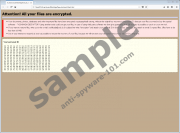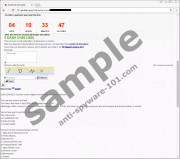Most likely, you have found this report and started reading it because you have already discovered Yoshikada Ransomware on your computer. This is a new crypto-threat, but it does the same job as many other ransomware-type infections. That is, this nasty infection locks users’ personal files right away after slithering onto their computers without their knowledge. A motive behind this activity is only one – to obtain money from users. If this threat has already entered your system without your knowledge, and locked your files, you should be able to find a new file on your computer. This file is a ransom note. You might not find the exact amount of money you have to send to cyber criminals indicated in it, but you will find out that you need to purchase the special decryptor from cyber crooks so that you could unlock those encrypted files. If you do not know what to do, we want you to know that we do not recommend transferring money to crooks no matter how much money they ask. It is unclear whether you will get the tool you pay for. Cyber criminals might change their minds and not give it to you. In this case, you could only blame yourself because nothing else could be done. In addition, if you send money to them, they will realize that it is worth spending time on the development of malware. Consequently, you might encounter new harmful threats in the future. Read more »
Trojans - Page 79 category archyve:
CrossRAT
CrossRAT is a Trojan that was found spreading via malicious links that are sent randomly via email, Facebook, WhatsApp, and other social networking platforms. The link should be supported by a misleading message to make you think that nothing bad will happen if you click it. Unfortunately, many bad things can happen if you let the Trojan in because it enables attackers to access your operating system remotely. The worst part about it all is that this infection is very clandestine, and it is unlikely that you will realize that it is active right away. Needless to say, the longer this infection is active, the more trouble you are likely to get in. Our research team at Anti-Spyware-101.com has tested the threat and has devised instructions that show how to delete it. If you are still unsure if you even need to remove CrossRAT from your operating system, quickly install and run a legitimate malware scanner. You should take this step even if you have already unveiled the Trojan because you want to check if any other malicious threats are active. Read more »
MADA Ransomware
If you have just been presented with a pop-up warning saying that your files are encrypted by the MADA ransomware, that means that you are dealing with another version of the Jigsaw ransomware. The Jigsaw ransomware is notorious for its capability to delete files at regular intervals, and the same action is performer by its spin-offs. The MADA ransomware should removed immediately after being detected, and preventative measures should be taken to prevent future ransomware and malware attacks. Read more »
Ransomuserlocker Ransomware
If a black window with red letters has been opened on your screen, and it is no longer possible to open a bunch of files, Ransomuserlocker Ransomware must have entered your system. It is one of those nasty infections that encrypt files on users’ computers right away after infiltrating them. It is not a prevalent infection, but it might still enter your system one day without your knowledge. Even though this malicious application is one of those threats that arrive on users’ computers without permission, it does not stay unnoticed for a long time because users’ usually soon discover that their important files and pictures have been locked. The first thing you should do after discovering Ransomuserlocker Ransomware active on your system is to fully remove the ransomware infection from the system. This Korean infection does not create any entries in the Run registry key like some other file-encrypting threats, so it cannot start working automatically on users’ computers; however, you might launch it yourself accidentally and, after doing this, discover more files locked, not to mention that the black window with a ransom note in Korean will be opened on your screen once again. Luckily, this window is not opened in full-screen, so you could still access system utilities and erase the ransomware infection from the system. Continue reading to find out what you need to do to delete this infection manually from your computer. Read more »
EncryptServer2018 Ransomware
A new malicious application has been discovered by specialists at anti-spyware-101.com. It has been named EncryptServer2018 Ransomware. One of the reasons it has such a name is because it encrypts files on servers and appends the .2018 extension to all affected files. Yes, this threat targets Windows Servers primarily, but we cannot guarantee that you will not discover this malicious application on your computer one day. If it ever finds a way to enter your system unnoticed, we are sure you will still soon find out about its entrance because you will discover a number of files encrypted. There is a reason why this malicious application locks files on compromised computers. Cyber criminals behind this infection use it as a tool to obtain money from users more easily. If your files have already been encrypted, and you are one step away from sending money to crooks, you should know that there are no guarantees that you will get a tool to decrypt your files. It is the main reason our specialists do not consider sending money to the author of the ransomware infection a good solution to this problem. Either way, the ransomware infection needs to be removed from the system completely as soon as possible. Read more »
Msttc.exe Miner Bitcoin
If your computer became slower than usual and you see a suspicious process called msttc.exe running in the background, you probably encountered a Trojan called Msttc.exe Miner Bitcoin. Under such circumstances, it would be best to delete it with no hesitation. However, before using the removal instructions available at the end of this article, we advise you to read the rest of the text first and get to know this malicious program better. Further, in the text, we will describe its effective manner and explain why it would be a bad idea to leave this malware unattended. Moreover, we will also talk about the Trojan’s possible distribution channels, so if you do not wish to come across a threat similar to Msttc.exe Miner Bitcoin, you will find tips suggesting how to maintain the system clean as well. Read more »
CCord SystemLocker
CCord SystemLocker is a computer infection that is classified as ransomware. It means that it holds your computer hostage and wants you to pay a ransom fee. If you pay the fee, the program will give you your system back, or so it says. These days, when we deal with ransomware programs, we usually expect to encounter the encrypting ransomware programs that scramble user’s files and then wait for users to pay for the decryption key. CCord SystemLocker, on the other hand, does not do anything of the sort. This program locks your screen, and you need to remove the infection for good if you want to access your desktop again. Read more »
Lebal
Lebal is a nasty malicious application that will steal information from your computer if it ever slithers onto it. To tell you the truth, it seems that this infection primarily targets private companies, organizations, and institutions, but, of course, you cannot be so sure that you will never find it on your computer either, so you should be cautious 24/7. If you suspect that you could have become one of the victims of this nasty threat, scan your system with an antimalware scanner or check the main folders on your computer yourself. You should be able to find malicious .exe files representing Lebal in %TEMP%, %USERPROFILE%\Desktop, or %USERPROFILE%\Downloads. If it turns out to be true that you have a Trojan active on your computer, you must delete it as soon as possible. Unfortunately, it usually takes some time for users to realize that they have this Trojan because these threats enter computers illegally and perform activities in the background. Specifically speaking, Lebal is a threat used to steal personal information from users’ computers. As a consequence, if you do not disable it, privacy-related problems will arise sooner or later. It is not so easy to delete Trojans manually, but we promise to help you erase it – continue reading! Read more »
GandCrab Ransomware
GandCrab Ransomware is yet another file encrypting infection that was created by cyber criminals to take your money. Just like most other threats of this kind, the ransomware could slither into the targeted system using corrupted spam emails and known security backdoors, but our Anti-spyware-101.com malware researchers have found that the threat can also be spread using the RigEK exploit kit. RigEK delivers malicious payload when the victim visits an unsecure website. After this, it employs Javascript to check for any vulnerable plug-ins that could be exploited. At the time of research, the ransomware was mostly affecting Windows users in South Korea, the United States, China, and Russia, but that does not mean that you are safe if you live in a different region. If you still have time, you need to protect your operating system as soon as possible, but if the malicious infection has already invaded, you need to focus on deleting it first. If you do not know how to remove GandCrab Ransomware, you will find useful information in this report. Read more »
Blacknord@tutanota.com Ransomware
You do not want to encounter Blacknord@tutanota.com Ransomware, believe us. Research conducted by specialists working at anti-spyware-101.com has clearly shown that this malicious application is one of those threats mercilessly encrypting users’ files. As a consequence, it is called crypto-malware by researchers. If it is already too late for prevention, i.e. if you have discovered the ransomware infection on your computer, you cannot turn the clock back and prevent it from entering your system, but it does not mean that you have to live with Blacknord@tutanota.com Ransomware active on your system. Specialists say that this threat should be removed from the system as soon as possible because it does not stop working after encrypting files on affected computers. It creates a Value in the Run registry key, so it continues working even if the affected machine is rebooted. If it is not disabled, you might find more files encrypted on your computer soon. We are sure you do not want to discover more ruined files, so we will help you to delete Blacknord@tutanota.com Ransomware fully. Continue reading this report for now. Read more »






